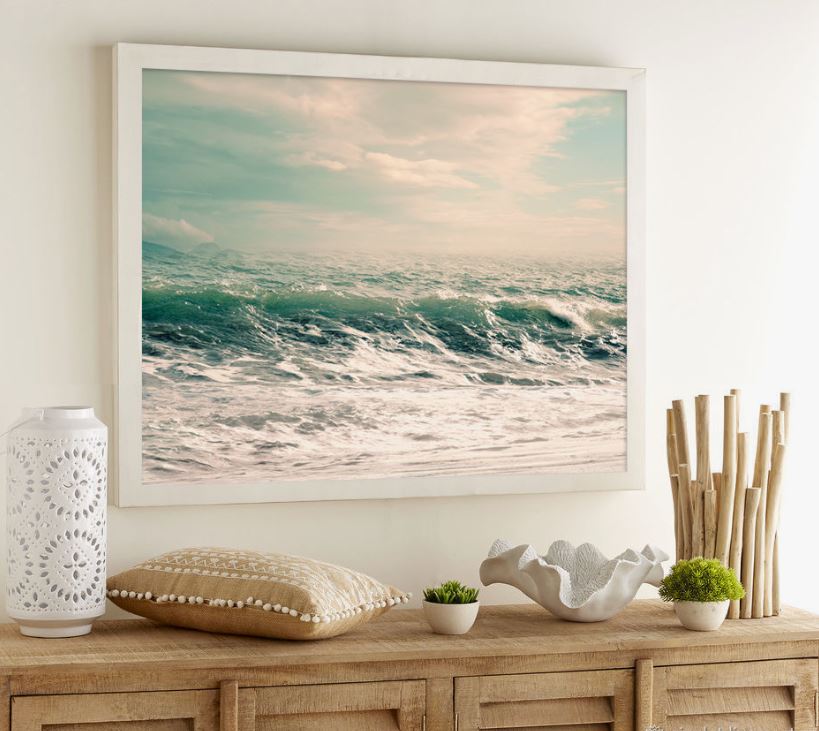Beginner painters are often surprised by how much the type of canvas can impact their work. While it may not be obvious at first, understanding the differences between canvas types is crucial as you progress in your painting journey. In fact, even as a beginner, you’ll likely find it difficult to revert to cheaper canvases once you’ve experienced the quality of a higher-grade canvas.
Today, we’re exploring how to choose the perfect canvas type for coastal art work, including the pros and cons of various canvas types to help you make an informed decision.
Cotton Duck Canvas
Cotton duck canvas is the most common type of canvas available today. Despite its name, it’s not made from ducks. Cotton duck canvas is affordable and comes in multiple weights and weaves, making it a popular choice for beginners.
- Weight and Weave: Cotton duck canvas is classified based on its surface texture weight and the tightness of its weave. Cheaper cotton canvases tend to have a looser weave and lighter weight, featuring shorter cotton fibers. This makes them stretchier than linen, which can be an advantage for large canvas projects as they are easier to stretch and adjust.
- Pros: Affordable, easy to stretch, and available in various weights and weaves.
- Cons: Less durable, can sag over time, and may not provide the best surface for detailed work.
Linen Canvas
Linen is the second most popular canvas type for painting, often considered superior to cotton due to its strength and durability.
- Durability: Linen is stronger and more durable than cotton, making it resistant to mold and mildew. It doesn’t expand and contract as much due to moisture, reducing the risk of bacterial growth. Additionally, linen retains its natural oil content, preserving the fiber’s long-term flexibility.
- Quality and Cost: Because of its superior quality, linen is more expensive. Most linen canvases are sourced from western Europe, contributing to the higher cost compared to cotton canvases, which are often sourced from India.
- Smoothness: Linen canvases are available in a range of textures, from very smooth to very rough, allowing artists to choose the best surface for their specific needs.
- Pros: Strong, durable, resistant to moisture and bacteria, retains flexibility.
- Cons: More expensive, may require more preparation time.
Synthetic Canvas Types
For those who want the benefits of linen without the high cost, synthetic canvas might be the perfect solution.
- Synthetic Linen: Advances in technology have made synthetic linen a viable option for many artists. These canvases can mimic the qualities of natural linen while being more affordable.
- Cotton-Poly Blends: Some artists prefer synthetic cotton-poly blends, which combine synthetic and cotton fibers. These blends offer the advantages of cotton, such as lower costs, without the downsides like stretching and weaker fabric. This results in smoother canvases that are ideal for detailed work.
- Brand Selection: The quality of synthetic canvases can vary significantly between brands. It’s important to choose a reputable brand to ensure you get a high-quality product.
- Pros: Cost-effective, durable, available in a variety of textures.
- Cons: Quality can vary, less traditional feel compared to natural fibers.
Choosing How Your Canvas Will Be Used
After selecting the material, you need to decide how your canvas will be used. There are three main options to consider:
Stretched Canvas
Stretched canvas is the most convenient option but comes with a higher initial cost.
- Convenience: Stretched canvases are ready to use immediately, often already primed and stretched over a frame. This makes them a great choice for artists who want to start painting right away.
- Display: Many stretched canvases can be hung without a frame, depending on how they are stretched and stapled.
- Pros: Ready to use, convenient, no need for additional stretching or framing.
- Cons: Higher cost, limited size options.
Canvas Panels
Canvas panels offer a more affordable alternative to stretched canvas while still providing many of the same benefits.
- Affordability: Canvas panels consist of canvas or linen glued to a heavy-duty card or wooden press board. They are cheaper than stretched canvases but still provide a stable surface for painting.
- Portability: These panels are lightweight and portable, making them ideal for plein air painting or travel.
- Framing: After painting, canvas panels usually require framing. However, because they are thin, you have flexible framing options, including any frame molding or metal frames.
- Pros: Affordable, portable, versatile framing options.
- Cons: Requires framing after painting, less durable than stretched canvases.
Canvas Rolls
For those looking for the most cost-effective option, canvas rolls offer great flexibility and savings.
- Customization: Canvas rolls provide endless size possibilities, allowing you to create custom canvas and panel sizes. They are available in linen or cotton with various weights and weaves.
- Cost: Canvas rolls are the cheapest way to acquire large amounts of canvas. However, they require additional work to stretch on canvas stretcher frames or to make your own panels.
- Hard Work: Using canvas rolls can be time-consuming and requires some skill in stretching and preparing the canvas. Many artists find that they get used to the process over time, reducing the preparation time.
- Pros: Cost-effective, customizable sizes, available in various materials.
- Cons: Time-consuming preparation, requires additional tools and skills.
Conclusion
Choosing the right canvas type is crucial for achieving the best results in your beach house wall decor. Whether you opt for the affordability of cotton duck canvas, the durability of linen, or the cost-effectiveness of synthetic options, understanding the pros and cons of each type will help you make an informed decision. Consider how you plan to use your canvas and your budget to find the perfect match for your artistic needs. By doing so, you’ll set yourself up for success and enjoy the painting process even more.

